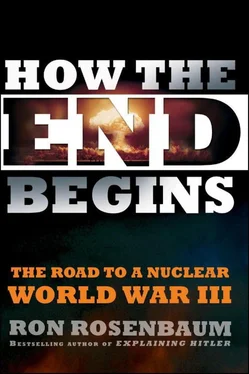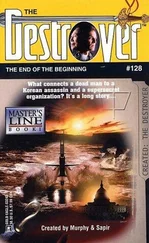On the other hand we don’t know what secret communications about the situation had been conveyed to the Russians in addition to Hadley’s public statement. We may have made it clear that arming the SS-26s with nuclear warheads would risk turning the confrontation into a nuclear standoff, or that we were aware of their nukes but were prepared to match them if the Russians rolled over the rest of Georgia as it looked for a day or so they might. The fact they didn’t take advantage of this easy opportunity to eliminate a thorn in their side might be an indication that it was they who were deterred.
The SS-26s have surfaced more than once in the last three years. [278]Just hours after Obama was elected president, Russia announced it would base them within range of our planned missile defense site in Poland. This move was meant to “neutralize” the planned missile defense system that the Bush administration had wanted to deploy in Eastern Europe. Was it deterrence that caused the Obama administration to abandon the Polish interceptor plan?
Both the Bush and Obama Pentagon have stated repeatedly that the defensive shield is designed to protect the continent from missiles launched from rogue states, such as Iran. But Moscow rejects that argument, claiming that the system is actually aimed at Russia. So Russia also made it clear in December 2009 that it had plans to jam a radar located in the Czech Republic used to detect in-bound missiles and intended to guide the projected Polish-based interceptors. The Bush plan was thankfully revoked [279]when Obama came into office, (but replaced by a sea-based system and a Romanian land-based interceptor installation, that are no less objectionable to the Russians) and that may have been Putin and Medvedev’s intention all along. The Russians were clearly mounting a challenge to Bush’s successor, who has said he is opposed to “unproven” missile defense systems. The Associated Press story describing the nuclear brinkmanship was a concatenation of Cold War clichés: “In some respects,” it said, “the SS-26 movement to Kaliningrad [the Russian outpost closest to the proposed Polish interceptor base] is the first ‘shot across the bow’ of the incoming administration. Moscow is waiting to see if Obama has ‘steel in his spine,’ and will stand up to a deliberate Russian provocation. So are our Eastern European allies, who wonder if the new president will stand with them against the Russian bear.” [280]
These are strong words: “Shot across the bow,” “steel in his spine,” “stand with them against the Russian bear.” World War III is back in words if not yet in deed.
When I asked Colonel Gardiner what he’d learned about war-gaming over the years of engaging in it, he told me that it often comes down to finding out “What is the killer question.”
He gave an example from his experience in war game exercises he participated in during the Cold War: “Could the Belgian core hold?” The Belgian core was the weak spot in the north–south dividing line between NATO and the Warsaw Pact powers. The geographical weak spot. The likely attack point.
Would we have the credibility to convince the Soviets that we could hold the Belgian core with conventional forces without having to resort to nukes to stop a breakthrough?
Colonel Gardiner had a fascinating account of how we sought to make the Soviets believe that our Fifth Corps would “move up to reinforce the Seventh Corps” in holding the Belgian core, thus discouraging the Warsaw Pact from focusing its forces on the apparent weakness. The killer question was: did they believe us? Apparently. According to Gardiner, we leaked plans through a spy that we’d make that move, thereby implying that we were inviting them into a trap. Then we acted out the move during a war game exercise Gardiner participated in and incorporated the Seventh Corps deception into our actual war plan. “Deception was the essence of credibility,” was his way of summing it up.
But in terms of today’s war-gaming the new nuclear age flashpoints, Gardiner was most concerned about the urgency of the Pakistan problem. “You want to know where the Pakistani nukes are? I can show you on Google maps,” he said.
“You mean they’re not exactly secure.”
“What do you think?” he said.
In the Iranian-American war game Gardiner ran for The Atlantic magazine, [281]the killer question was whether Iran would credibly retaliate against an American attack on its nuclear facilities. Or would they refrain because any retaliation would certainly bring on the kind of obliteration promised Iran by Secretary of State Hillary Clinton, who used that formulation in one of the primary debates. She was referring to our willingness to provide Israel with a nuclear umbrella: a pledge to obliterate Iran if it nuked Israel.
In that war game, the conclusion was that Iran would retaliate, in the Persian Gulf, taking out U.S. aircraft carriers and battleships with Chinese Silkworm missiles, obliterating shipping in the Strait of Hormuz, destroying the Saudi oil refineries and with them much of the West’s energy supplies, not to mention—depending on the time frame—sending a Shehab-3 ballistic missile or two or more heading toward Israel, Western Europe, and, for all we knew, the Western Hemisphere as well. [282]The fact that some of the best-informed Western experts on Iran discounted the potency of deterrence is an ominous indication that a global nuclear war could erupt from supposed surgical strikes on Iran.
Syria however, was deterred on the night of September 6, 2007. An attack on its territory left a key nearly completed nuclear facility of some kind obliterated and the Syrians were silent. And the Iranians may have had some kind of mutual defense pact with the Syrians, but did nothing. The Syrians are known to possess missiles with the capacity to deliver chemical weapons into the heart of Israel’s major cities and they didn’t use them because, they knew—they were deterred by—Israeli nuclear capacity to leave Damascus a radioactive ruin.
The night we came so close to World War III we danced on the knife’s edge of deterrence and lived to see another day. But what if things had played out just a little bit differently?
When I think about the Enigmatic Box and the close call it represented I can’t help thinking of Pandora’s box, which, in the myth, when opened against warnings, released all the evils of the world. At the bottom of Pandora’s box of course there was said to be one remaining thing: hope. Did the events of April 2010 recounted in the next chapter represent hope? That’s the killer question.
THE SURPRISING REBIRTH OF ZERO
Hope springs eternal; but so does false hope. President Barack Obama and Russian president Dmitri Medvedev finally signed the much delayed “follow-on” of the START treaty—“New START” as the optimistic Obama press releases called it. But the treaty was a tacit recognition that nukes are here to stay. It leaves thousands of them on hair-trigger alert and perpetuates the ideology at the heart of deterrence theory: threaten genocide to prevent genocide. The day before the president departed for the Prague signing, the Pentagon released the first Obama administration Nuclear Posture Review (or NPR), [283]a fifty-page document whose departure from the previous one by the Bush administration was hailed by some for its stated intention to make nuclear weapons less central to U.S. military strategy. But it was a rhetorical reset rather than a breakaway from the straitjacket of deterrence theory. “A status quo document,” Bruce Blair told the Wall Street Journal . [284]In fact, both the treaty and the NPR were status quo documents that left open the question of whether the status quo was sustainable.
Читать дальше











